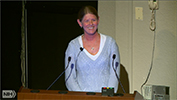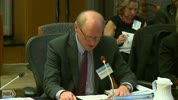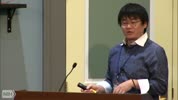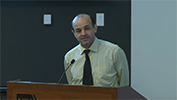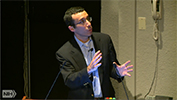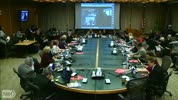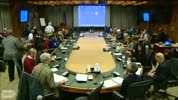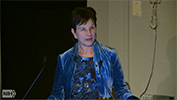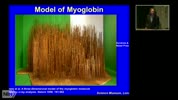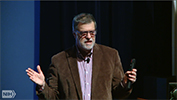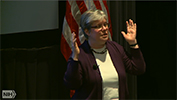-
- NIH VideoCast - Peripheral immune system in health and disease of the brain
-
- - Jonathan Kipnis, Ph.D., University of Virginia School of Medicine (2016/02/03)
- - Category : Neuroscience
- NIH Neuroscience Seminar Series
In Dr. Kipnis lab they are working to better understand the complex interactions between the immune and nervous systems. Until very recently, scientists assumed that any activity of the immune system within or around the central nervous system (CNS) was a hallmark of pathology. However, multiple new lines of evidence support the notion that immune support is actually required for optimal neuronal survival following CNS injury. In parallel, they recently showed that immune-compromised mice exhibit behavioral and cognitive abnormalities when compared to mice with normally-functioning immune systems. Animals that lack the population of unique T lymphocytes, or key molecular factors produced by these cells, are strikingly impaired in learning and memory tasks, adult neurogenesis, and neuronal plasticity. Moreover, a well-controlled boost of immune response improves learning abilities in normal animals and accelerates the process of neurogenesis. Their goal is to elucidate the cellular and molecular mechanisms underlying the beneficial effects of immune cells in healthy and diseased CNS. On the therapeutic ???frontline???, they are designing vaccines and developing novel therapies with a potential to promote neuronal survival, improve cognitive functions, and slow down progression of neurodegenerative, neurodevelopmental and cognitive disorders.
NIH VideoCast - Peripheral immune system in health and disease of the brain
-
- NIH VideoCast - Introduction to the Principles and Practice of Clinical Research (IPPCR) 2016: Concepts in Pharmaceutical Development Project Management
-
- - Christopher D. Breder, M.D., Ph.D., FDA (2016/02/03)
- - Category : IPPCR
- The Introduction to the Principles and Practice of Clinical Research (IPPCR) is a course to train participants on how to effectively conduct clinical research. The course focuses on the spectrum of clinical research and the research process by highlighting epidemiologic methods, study design, protocol preparation, patient monitoring, quality assurance, and Food and Drug Administration (FDA) issues.
For more information go to http://clinicalcenter.nih.gov/training/training/ippcr1.html
NIH VideoCast - Introduction to the Principles and Practice of Clinical Research (IPPCR) 2016: Concepts in Pharmaceutical Development Project Management
-
- NIH VideoCast - Principles of Clinical Pharmacology ~ Disease Progression Models and Clinical Trial Simulation
-
- - Diane R. Mould, Ph.D., FCP, Projections Research Inc. (2016/02/02)
- - Category : Principles of Clinical Pharmacology
- The "Principles of Clinical Pharmacology" course is a weekly lecture series covering the fundamentals of clinical pharmacology as a translational scientific discipline focused on rational drug development and utilization in therapeutics. The course is offered annually at the NIH Clinical Center and runs from September through April.
NIH VideoCast - Principles of Clinical Pharmacology ~ Disease Progression Models and Clinical Trial Simulation
-
- NIH VideoCast - NIGMS Council Open Session - January 2016
-
- - Dr. Jon Lorsch, NIGMS, NIH (2016/02/02)
- - Category : Advisory Board Meetings and Workshops
- Open session of the January, 2016 NIGMS Council
NIH VideoCast - NIGMS Council Open Session - January 2016
-
- NIH VideoCast - Council of Councils - January 2016
-
- - NIH (2016/02/02)
- - Category : Council of Councils
- The Council of Councils was created by the NIH Reform Act of 2006, and advises on matters related to the policies and activities of DPCPSI, including concept clearance of selected initiatives for Common Fund support and proposed Office of Research Infrastructure Program (ORIP) initiatives. The Council conducts second-level review for selected Common Fund and ORIP initiatives.
For more information go to http://dpcpsi.nih.gov/council/index
NIH VideoCast - Council of Councils - January 2016
-
- NIH VideoCast - Dissecting branching morphogenesis and coordinated wiring of the vascular and nervous systems
-
- - Yosuke Mukoyama, Ph.D., Senior Investigator, National Heart, Lung, and Blood Institute, NIH (2016/02/02)
- - Category : NIH Director`s Seminars
- Director`s Seminar Series
Branching morphogenesis is a fundamental attribute of many organs. As examples of highly informative model systems, we have focused our studies on two major branching networks, the vascular and nervous systems, which share several anatomical and functional characteristics, and are often patterned similarly in peripheral tissues. Combining high-resolution whole-mount imaging, advanced genetic perturbations, and in vitro organ culture techniques, we are elucidating, at molecular level, how sensory nerves controls vascular branching morphogenesis and how sympathetic nerves are guided by neighboring blood vessels during organ development. Ongoing studies are focusing on understanding the developmental programs of branching morphogenesis and patterning in the neuro-vascular wiring at single cell resolution, how they restart these programs during tissue regeneration, and how they go awry in disease conditions including obesity-related nerve disorders.
NIH VideoCast - Dissecting branching morphogenesis and coordinated wiring of the vascular and nervous systems
-
- NIH VideoCast - CC Grand Rounds:(1) Cortisol: Too Much, Too Little or Just Right?(2) Substrates for Differential Responsivity in Women with Reproductive Endocrine-related Mood Disorders
-
- - Lynnette Nieman, MD, Senior Investigator, Section on Reproductive Endocrinology, NICHD, NIH and (2) Peter Schmidt, MD, Chief, Behavioral Endocrinology Branch, NIMH, NIH (2016/01/31)
- - Category : Clinical Center Grand Rounds
- CC Grand Rounds:(1) Cortisol: Too Much, Too Little or Just Right?(2) Substrates for Differential Responsivity in Women with Reproductive Endocrine-related Mood Disorders br>
For more information go to http://www.cc.nih.gov/about/news/grcurrent.html
NIH VideoCast - CC Grand Rounds:(1) Cortisol: Too Much, Too Little or Just Right?(2) Substrates for Differential Responsivity in Women with Reproductive Endocrine-related Mood Disorders
-
- NIH VideoCast - High-Performance Integrated Virtual Environment (HIVE): A regulatory NGS data analysis platform
-
- - Vahan Simonyan, Ph.D and Raja Mazumder, Ph.D. (2016/01/31)
- - Category : Special
- Abundance of miscellaneous high performance computational platforms available across academia, healthcare industry, and in government organizations isn`t doing much to close the gap between research and regulatory analytics. Extra iterations for drug, device and biologics approval process are causing a significant cost increase for medical product development. High-Performance Integrated Virtual Environment (HIVE) co-developed by FDA and GW presents a great opportunity for serving as a bridge. It is authorized as a regulatory NGS data analysis platform and provides unique capability for healthcare stakeholders to look into NGS data from regulatory perspective of FDA.
As a distributed storage and computation environment and a multicomponent cloud infrastructure, HIVE provides secure web access for authorized users to deposit, retrieve, annotate, and compute on biomedical big data, and to analyze the outcomes using web interface visual environments appropriately built in collaboration with internal and external end users. In addition to the initial HIVE applications to next generation sequencing, the current universe of HIVE projects covers tailor-made applications involving dimensionality analysis, federated and integrated data mapping, modeling and simulations that are applicable to basic research, biostatistics, epidemiology, clinical studies, post-market evaluation, manufacturing consistency, environmental metagenomics, outbreak detection, and more.
NIH VideoCast - High-Performance Integrated Virtual Environment (HIVE): A regulatory NGS data analysis platform
-
- NIH VideoCast - NEI Council - January 2016
-
- - NEI, NIH (2016/01/30)
- - Category : Advisory Board Meetings and Workshops
- NEI Council "OPEN Session" Meeting for public access
NIH VideoCast - NEI Council - January 2016
-
- NIH VideoCast - Neural circuits controlling sleep
-
- - Yang Dan, Ph.D., University of California, Berkeley (2016/01/29)
- - Category : WALS - Wednesday Afternoon Lectures
- NIH Director`s Wednesday Afternoon Lecture Series
Yang Dan???s lab uses electrophysiology, imaging, optogenetic, and computational techniques to study functions of the mammalian brain. They have studied microcircuits underlying visual cortical computation and mechanisms for cortical plasticity at multiple levels, from synapse to perception. Recent work has revealed the mechanisms by which brainstem, hypothalamus, and basal forebrain circuits exert powerful control of sleep-wake brain states.
For more information go to https://oir.nih.gov/wals
NIH VideoCast - Neural circuits controlling sleep
-
- NIH VideoCast - Novel Roles for Oxysterols in Resolution of Inflammation and Critical Illness
-
- - Michael B. Fessler, M.D.; Senior Investigator; Immunity, Inflammation, and Disease Laboratory, NIEHS, NIH (2016/01/29)
- - Category : Immunology
- Immunology Interest Group
Michael Fessler is a physician scientist who is a Senior Investigator and Deputy Chief of the Immunity, Inflammation, and Disease Laboratory of the intramural research program at NIEHS/NIH. Mike received his M.D. at Harvard Medical School in 1996, after which he completed an internal medicine residency at Massachusetts General Hospital from 1996-1999, and then a pulmonary-critical care fellowship at University of Colorado from 1999-2002. In 2006, after four years on faculty at National Jewish Hospital, Mike started as a Tenure Track Investigator at NIEHS, and, in 2013, he received tenure. His laboratory focuses on the innate immune response, with a particular interest in mechanisms by which cholesterol trafficking through macrophages and the lung regulates host defense. His laboratory has helped to define the role of cholesterol transporters in regulation of lung inflammation and immunity, the role of lipid rafts in TLR signaling, and the therapeutic potential of statins and Liver X Receptor agonists in preclinical models of lung disease. In 2012, Mike received the Carol Basbaum Award from the American Thoracic Society, and in 2015 was inducted into the American Society for Clinical Investigation. Talk Abstract: Recent reports have revealed there to be substantial steady state flux of cholesterol through the lung, and have interestingly indicated that cholesterol trafficking may be uniquely coupled to immune and inflammatory responses in this organ. The oxysterol-activated nuclear receptor, Liver X Receptor (LXR), is in particular positioned at the crossroads of lipid homeostasis and immunity as it coordinately promotes cellular cholesterol mobilization and suppresses NF-??B-dependent inflammation. Here, we identify cholesterol-25-hydroxylase (Ch25h)-derived 25-hydroxycholesterol (25HC) as a lipopolysaccharide (LPS)-induced oxysterol that is uniquely required for promoting LXR-dependent resolution of inflammation in the lung. LPS inhalation upregulates Ch25h in pulmonary macrophages, inducing 25HC in the murine and human airspace in vivo. Ch25h-null mice do not induce 25HC after LPS and display abrogated activation of LXR in the lungs and accumulation of lipid-laden macrophage ???foam cells.??? This is associated with deficient resolution of alveolar neutrophilia similar to that seen in Lxr-null mice, and is associated with defects in macrophage-mediated efferocytosis, TGFb induction, and recruitment of Tregs to the airway. Ch25h is induced in macrophages during efferocytosis, and Ch25h-null efferocytic macrophages display defective LXR activation, failing to induce the LXR target gene and efferocytosis receptor Mertk. We show that resolution in Ch25h-null mice is rescued by treatment with either 25HC or synthetic LXR agonists. Suggesting a potential class effect of LXR-active oxysterols in resolution of inflammation, we also show that human alveolar macrophages synthesize the oxysterol cholestenoic acid and that, in acute lung injury patients, plasma cholestenoic acid is inversely related to pro-inflammatory biomarkers and duration of organ failure. Taken together, oxysterols are bioactive lipids that play a key protective role through coordinate promotion of lipid and inflammatory homeostasis. We propose that these insights have potential therapeutic relevance to human lung disease.
NIH VideoCast - Novel Roles for Oxysterols in Resolution of Inflammation and Critical Illness
-
- NIH VideoCast - NICHD Advisory Council - January 2016
-
- - NICHD, NIH (2016/01/28)
- - Category : National Institute of Child Health and Human Development
- To help achieve the goals of the Institute, the NACHHD Council is charged with advising, consulting with, and making recommendations to the NICHD director on matters relating to the research and research support activities and functions of the Institute.
NIH VideoCast - NICHD Advisory Council - January 2016
-
- NIH VideoCast - National Advisory Council on Aging (NACA) - January 2016
-
- - NIA, NIH (2016/01/26)
- - Category : Advisory Board Meetings and Workshops
- The National Advisory Council on Aging (NACA) advises the Secretary of the U.S. Department of Health and Human Services, the Director of NIH, and the Director of NIA on its mission. The Council meets three times a year to consider applications for research and training.
NIH VideoCast - National Advisory Council on Aging (NACA) - January 2016
-
- NIH VideoCast - Principles of Clinical Pharmacology ~ Physiological and Laboratory Markers of Drug Effect
-
- - Dr. Janet Woodcock, FDA (2016/01/23)
- - Category : Principles of Clinical Pharmacology
- The "Principles of Clinical Pharmacology" course is a weekly lecture series covering the fundamentals of clinical pharmacology as a translational scientific discipline focused on rational drug development and utilization in therapeutics. The course is offered annually at the NIH Clinical Center and runs from September through April.
NIH VideoCast - Principles of Clinical Pharmacology ~ Physiological and Laboratory Markers of Drug Effect
-
- NIH VideoCast - CC Grand Rounds: (1) Effect of Non-glycemic Factors on Hemoglobin A1c Measurements and (2) Moving Beyond A1C to Detect Glycemia in African Descent Populations
-
- - (1) David B. Sacks, MB, ChB ,Chief, Clinical Chemistry Service, Department of Laboratory Medicine, CC, NIH and (2)Anne E. Sumner, MD, Section Chief, Section on Ethnicity and Health, Diabetes, Endocrinology, and Obesity Branch, NIDDK, NIH (2016/01/22)
- - Category : Clinical Center Grand Rounds
- CC Grand Rounds: (1) Effect of Non-glycemic Factors on Hemoglobin A1c Measurements and (2) Moving Beyond A1C to Detect Glycemia in African Descent Populations
For more information go to http://www.cc.nih.gov/about/news/grcurrent.html
NIH VideoCast - CC Grand Rounds: (1) Effect of Non-glycemic Factors on Hemoglobin A1c Measurements and (2) Moving Beyond A1C to Detect Glycemia in African Descent Populations
-
- NIH VideoCast - The social life of bacteria: collapse of a culture
-
- - E. Peter Greenberg, Ph.D., University of Washington School of Medicine (2016/01/22)
- - Category : WALS - Wednesday Afternoon Lectures
- Wednesday Afternoon Lecture Series
Dr. Greenberg is interested in how and why individual cells communicate with each other. In particular, he has studied the bacterial communication system???called quorum sensing???and how it controls cooperation in groups of bacteria. In his lecture, he will focus on a human pathogen, Pseudomonas aeruginosa, which uses a transcription factor called LasR to activate dozens of genes in response to the LasI-produced quorum-sensing signal 3OC12-HSL. The most overrepresented LasR-controlled genes code for the synthesis of exoproducts. Exoproducts are common goods that are made by individuals and shared within the group. Members of quorum-sensing groups are thus thought of as cooperators. Quorum-sensing cooperators, however, are susceptible to invasion by social cheaters???LasR mutants that benefit from cooperator-derived common goods without incurring a production cost. Greenberg will discuss three questions related to this bacterial social activity: 1) If social cheaters have a fitness advantage over cooperators, then how can cooperation be evolutionarily stable (Darwin???s dilemma)? He will describe one molecular mechanism that restrains cheating; 2) Why do cooperators and cheaters reach an equilibrium and co-exist with each other in some situations? He will describe how cooperators police cheaters; and 3) Can we manipulate conditions to induce a breakdown in cooperation and a catastrophic population crash? He will show that this crash can occur when the cost of cooperation is increased or when policing is eliminated. He will discuss the implications of this sociobiology view of P. aeruginosa population ecology in the context of chronic infections and general cell-cell interactions.
For more information go to https://oir.nih.gov/wals
NIH VideoCast - The social life of bacteria: collapse of a culture
-
- NIH VideoCast - Action and Traction at the Immunological Synapse
-
- - Janis Burkhardt, Ph.D.; Professor of Pathology and Laboratory Medicine, University of Pennsylvania Perelman School of Medicine; and Evelyn & George Willing Endowed Chair in Pathology Research, Children???s Hospital of Philadelphia (2016/01/22)
- - Category : Immunology
- Immunology Interest Group
Janis Burkhardt is an expert in the T cell cytoskeleton, studying both immunological and cell biological aspects of its function. She is currently Professor of Pathology and Laboratory Medicine at University of Pennsylvania School of Medicine as well as the Evelyn and George Willing Endowed Chair in Pathology Research at Children???s Hospital of Philadelphia. Over the years her lab has studied many aspects of immune cell function, including protein traffic and organelle motility in T and B cells, phagocytosis in macrophages, and actin regulatory networks in T cells and DCs. Using a combination of biochemical and microscopy-based approaches, she has identified many of the mechanisms though which specific receptors, kinases and adapter molecules choreograph the T cell cytoskeletal response. Now, she is striving to understand how actin dynamics in turn shape T cell and DC function, and how defects in cytoskeletal dynamics result in immunodeficiency or autoimmunity. Janis is very collaborative and an excellent mentor to trainees and junior faculty, with great interest in developing broad-based career guidance for doctoral and post-doctoral trainees. Signaling at the immunological synapse involves engagement of the TCR, costimulatory molecules and integrins on the T cell with cognate ligands on the APC. These receptor-ligand interactions trigger regulated actin dynamics within the T cell, which are in turn required for downstream signaling events leading to full T cell activation. We have found that centripetal flow of the T cell actin network regulates integrin conformational change, thereby promoting adhesion to ligands on the APC surface, as well as outside-in signals that costimulate T cell activation. This process is augmented by the cytoskeleton of interacting APCs, which constrains the lateral mobility of integrin ligands and thus opposes the forces exerted by the T cell cytoskeleton. In keeping with this tug-of-war mechanism, engagement of T cell integrins by low-mobility ligands slows actin flow within the T cell. Closer examination of the adhesive contacts formed by T cells reveals that they contain canonical focal adhesion proteins such as talin and vinculin. Consistent with the known role of these proteins in linking actin filaments to integrin cytoplasmic tails, suppression of these proteins relieves integrin-dependent retardation of actin flow. Taken together, these observations support a model in which integrin binding to the actin cytoskeletal network via talin and/or vinculin is a crucial step in modulating actin responses at the immunological synapse.
NIH VideoCast - Action and Traction at the Immunological Synapse
-
- NIH VideoCast - National Center for Advancing Translational Sciences Advisory Council/Cures Acceleration Network Review Board - January 2016
-
- - National Center for Advancing Translational Sciences, NIH (2016/01/21)
- - Category : NCATS Council
- The Jan. 14, 2016, joint meeting of the NCATS Advisory Council and the Cures Acceleration Network (CAN) Review Board will feature reports from NCATS Director Christopher P. Austin, M.D., and others about the Center???s initiatives, policies, programs and future direction. In accordance with Public Law 92-463, the session will be open to the public.
For more information go to http://www.ncats.nih.gov/events
NIH VideoCast - National Center for Advancing Translational Sciences Advisory Council/Cures Acceleration Network Review Board - January 2016
-
- NIH VideoCast - Principles of Clinical Pharmacology ~ Dose Response and Concentration Response Analysis
-
- - Dr. Juan J. L. Lertora, NIH (2016/01/21)
- - Category : Principles of Clinical Pharmacology
- The "Principles of Clinical Pharmacology" course is a weekly lecture series covering the fundamentals of clinical pharmacology as a translational scientific discipline focused on rational drug development and utilization in therapeutics. The course is offered annually at the NIH Clinical Center and runs from September through April.
NIH VideoCast - Principles of Clinical Pharmacology ~ Dose Response and Concentration Response Analysis
-
- NIH VideoCast - PMI Cohort Program Advisory Panel Meeting - January 2016
-
- - NIH (2016/01/21)
- - Category : Advisory Board Meetings and Workshops
- The PMI Cohort Program Advisory Panel is a working group of the NIH Council of Councils and was convened to provide external oversight and expert advice on the vision, scientific goals, and operations of the PMI Cohort Program. The Panel is charged with evaluating and providing recommendations regarding PMI Cohort Program Activities. Findings and recommendations of the Panel will report to the NIH Council of Councils for further consideration.
NIH VideoCast - PMI Cohort Program Advisory Panel Meeting - January 2016





